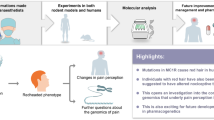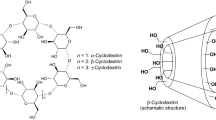Abstract
The effect of dipeptide Tyr-Pro, present in representatives of most families of opioid peptides, and two its analogs, Tyr-Pro-NH2 and Tyr-Pro-OMe, on analgesic activity was studied in different tests (tail-flick test, tail pinch (Haffner’s) test, formalin test, and acetic acid writing test) describing different organization levels of pain sensitivity. Intraperitoneal administration of the dipeptide decreased the pain threshold in all above-mentioned tests. Coadministration of the dipeptide and naloxone or naloxone methiodide insignificantly decreased the dipeptide analgesic effect in the tail-flick and acetic acid writing tests. Its analogs Tyr-Pro-NH2 and Tyr-Pro-OMe demonstrated a similar analgesic activity in the tail-flick test and a higher activity in the acetic acid writing test. Administration of individual amino acids (Tyr or Pro) or their mixture had no effect on the pain threshold.
Similar content being viewed by others
References
Alfeeva, L.Yu., Andreeva, L.A., Voronina, T.A., et al., A Family of Peptides with Analgesic Activity, RF Patent No. 2 286 169, 2005.
Bannon, A.W., Decker, M.W., Curzon, P., et al., [(R)-5-(2-Azetidinylmethoxy)-2-Chloropyridine]: A Novel, Orally Effective Antinociceptive Agent Acting via Neuronal Nicotinic Acetylcholine Receptors: II. In Vivo Characterization, J. Pharm. Exp. Ther., 1998, vol. 285, no. 2, pp. 787–794.
Bardin, L., Bardin, M., Lavarenne, J., and Eschalier, A., Effect of Intrathectal Serotonin on Nociception in Rats: Influence of the Pain Test Used, Exp. Brain Res., 1997, vol. 113, pp. 81–87.
Bowen, C.A., Fischer, B.D., Mello, N.K., and Negus, S.S., Antagonism of the Antinociceptive and Discriminative Stimulus Effects of Heroin and Morphine by 3-Methoxynaltrexone and Naltrexone in Rhesus Monkeys, J. Pharm. Exp. Ther., 2002, vol. 302, no. 1, pp. 264–273.
Braga, P. and Tiengo, M., Biella, G., et al., Dermorphin, A New Peptide from Amphibian Skin, Inhibits the Nociceptive Thalamic Neurons Firing Rate Evoked by Noxious Stimuli, Neurosci. Let., 1984, vol. 52, nos. 1–2, pp. 1651–1669.
Broccardo, M., Erspamer, V., Falconieri Erspamer, G., et al. Pharmacological Data on Dermorphins, A New Class of Potent Opioid Peptides from Amphibian Skin, Br. J. Pharmacol., 1981, vol. 73, no. 3, pp. 625–631.
Castiglione, R., Faoro, F., Perseo, G., et al., Synthetic Peptides Related to the Dermorphins. I. Synthesis and Biological Activities of the Shorter Homologues and of Analogues of the Heptapeptides, Peptides, 1981, vol. 2, no. 3, pp. 265–269.
Chernov, H.I., Wilson, D.E., Fowler, W.F., and Plummer, A.J., Non-Specificity of the Mouse Writhing Test, Arch. Int. Pharmacodyn. Ther., 1967, vol. 167, no. 1, pp. 171–178.
D’Amor, F.E. and Smith, D.L., A Method for Determining Loss of Pain Sensation, J. Pharm. Exp. Ther., 1941, vol. 72, no. 1, pp. 74–79.
Darlak, K., Benovitz, D.E., Spatola, A.F., and Grzonka, Z., Dermorphin Analogs: Resistance to in Vitro Enzymatic Degradation Is Not Always Increased by Additional D-Amino Acid Substitutions, Biochem. Biophys. Res. Commun., 1988, vol. 156, no. 1, pp. 125–130.
De Los Santos-Arteaga, M., Sierra-Dominguez, S.A., Fontanella, G.H. et al. Analgesia Induced by Dietary Restriction is Mediated by the κ-Opioid System, J. Neurosci., 2003, vol. 23, pp. 11 120–11 126.
Gergen, K.A., Zadina, J.E., Kastin, A.J., and Paul, D., Intrathecal Tyr-W-MIF-1 Produces Potent, Naloxone-Reversible Analgesia Modulated by Alpha 2-Adrenoceptors, Eur. J. Pharmacol., 1996a, vol. 298(33), pp. 235–239.
Gergen, K.A., Zadina, J.E., and Paul, D., Analgesic Effects of Tyr-W-MIF-1: A Mixed Mu2-Opioid Receptor Agonist / Mu1-Opioid Receptor Antagonist, Eur. J. Pharmacol., 1996, vol. 316, no. 1, pp. 33–38.
Haffner, F., Experimental Prufung Schmerzstillender Mittel, Dtsch. Med. Wschr., 1929, vol. 55, pp. 731–733.
Harrison, L.M., Kastin, A.J., and Zadina, J.E., Tyr-W-MIF-1 Attenuates Down-Regulation of Opiate Receptors in SH-SY5Y Human Neuroblastoma Cells, J. Pharm. Exp. Ther., 1998, vol. 284, no. 2, pp. 611–617.
Ji, Y., Murphy, A.Z., and Traub, R.J., Sex Differences in Morphine-Induced Analgesia of Visceral Pain Are Supraspinally and Peripherally Mediated, Am. J. Physiol. Regulatory. Integrative. Comp. Physiol., 2006, vol. 291, pp. R307–R314.
Kastin, A.J., Stephens, E., Ehrensing, R.H., and Fischman, A.J., Tyr-MIF-1 Acts As An Opiate Antagonist in the Tail-Flick Test, Pharmacol. Biochem. Behav., 1984, vol. 21, no. (6), pp. 937–941.
Kastin, A.J., Hahn, K., Erchegyi, J., et al., Differential Metabolism of Tyr-MIF-1 and MIF-1 in Rat and Human Plasma, Biochem. Pharmacol., 1994, vol. 47, no. 4, pp. 699–709.
Kuraishi, Y., Horota, N., Satoh, M., and Takagi, H., Antinociceptive Effects of Intrathectal Opioids, Noradrenaline and Serotonin in Rats: Mechanical and Thermal Analgesic Tests, Brain Res., 1985, vol. 326, pp. 168–171.
Makino, M., Kitano, Y., Komiyama, C., et al., Involvement of Central Opioid Systems in Human Interferon-Alpha Induced Immobility in the Mouse Forced Swimming Test, Br. J. Pharmacol., 2000, vol. 130, no. 6, pp. 1269–1274.
Melchiorri, P. and Negri, L., The Dermorphin Peptide Family, Gen. Pharmacol., 1996, no. 7, pp. 1099–1107.
Miller, L.G. and Kastin, A.J., MIF-1 and Tyr-MIF-1 Augment GABA-Stimulated Benzodiazepine Receptor Binding, Peptides, 1987, vol. 8, no. (5), pp. 751–755.
Negus, S.S., Pasternak, G.W., Koob, G.F., and Weinger, M.B., Antagonist Effects of Beta-Funaltrexamine and Naloxonazine on Alfentanil-Induced Antinociception and Muscle Rigidity in the Rat, J. Pharm. Exp. Ther., 1993, vol. 264, pp. 739–745.
Olsen, U.B., Eltorp, C.T., and Ingvardsen, B.K., et el. ReN 1869, A Novel Tricyclic Antihistamine, Is Active Against Neurogenic Pain and Inflammation, Eur. J. Pharmacol., 2002, vol. 435, no. 1, pp. 43–57.
Paul, D., Levison, J.A., Howard, D.H., et al., Naloxone Benzoylhydrazone (NalBzoH) Analgesia, J. Pharmacol. Exp. Ther., 1990, vol. 255, no. 2, pp. 769–774.
Rossi, A., di Salle, E., Briatico, G., et al., Antinociceptive, Prolactin Releasing and Intestinal Motility Inhibiting Activities of Dermorphin and Analogues after Subcutaneous Administration in the Rat, Peptides, 1983, vol. 4, no. 4, pp. 577–580.
Schiller, P.W., Nguyen, T.M., Chung, N.N., and Lemieux, C., Dermorphin Analogues Carrying an Increased Positive Net Charge in Their “Message” Domain Display Extremely High Mu Opioid Receptor Selectivity, J. Med. Chem., 1989, no. 3, pp. 698–703.
Shane, R., Wilk, S., and Bodnar, R.J., Modulation of Endomorphin-2-Induced Analgesia by Dipeptidyl Peptidase IV, Brain Res., 1999, vol. 815, no. 2, pp. 278–286.
Stevens, C. and Yaksh, T., Spinal Action of Dermorphin, An Extremely Potent Opioid Peptide from Frog Skin, Brain Res., 1986, vol. 385, no. 2, pp. 300–304.
Walker, J.M. and Hohmann, A.G., Cannabinoid Mechanisms of Pain Suppression, Handb. Exp. Pharmacol., 2005, no. 168, pp. 509–554.
Zadina, J.E. and Kastin, A.J., Interactions between the Antiopiate Tyr-MIF-1 and the Mu Opiate Morphiceptin at Their Respective Binding Sites in Brain, Peptides, 1985, vol. 6, no. 5, pp. 965–970.
Zadina, J.E., Kastin, A.J., Krieg, E.F., J., and Coy, D.H., Characterization of Binding Sites for N-Tyr-MIF-1 (Tyr-Pro-Leu-Gly-NH2) in Rat Brain, Pharmacol. Biochem. Behav., 1982, vol. 17, no. 6, pp. 1193–1198.
Zadina, J.E., Kastin, A.J., Ge, L.J., and Brant, I.V., Hemorphins, Cytochrophins, and Human beta-Casomorphins Bind to Antiopiate (Tyr-MIE-1) as Well as Opiate Binding Sites in Rat Brain, Life Sci., 1990, vol. 47, no. 8, pp. PL25–PL30.
Zadina, J.E., Kastin, A.J., Ge, L.J., and Hackler, L., Mu, Delta, and Kappa Opiate Receptor Binding of Tyr-MIF-1 and of Tyr-W-MIF-1, Its Active Fragments, and Two Potent Analogs, Life Sci., 1994, vol. 55, no. (24), pp. L461–L466.
Zadina, J.E., Paul, D., Gergen, K.A., et al. Binding of Tyr-W-MIF-1 (Tyr-Pro-Trp-Gly-NH2) and Related Peptides to mu 1 and mu 2 Opiate Receptors, Neurosci. Lett., 1996, vol. 215, no. 1, pp. 65–69.
Author information
Authors and Affiliations
Corresponding author
Additional information
Original Russian Text © L.S. Guzevatykh, T.A. Voronina, T.G. Emel’yanova, L.A. Andreeva, L.Yu. Alfeeva, S.B. Seredenin, N.F. Myasoedov, 2008, published in Izvestiya Akademii Nauk, Seriya Biologicheskaya, 2008, No. 1, pp. 61–67.
Rights and permissions
About this article
Cite this article
Guzevatykh, L.S., Voronina, T.A., Emel’yanova, T.G. et al. Analgesic activity of dipeptide Tyr-Pro. Biol Bull Russ Acad Sci 35, 50–55 (2008). https://doi.org/10.1134/S1062359008010081
Received:
Published:
Issue Date:
DOI: https://doi.org/10.1134/S1062359008010081




